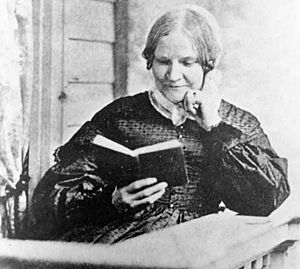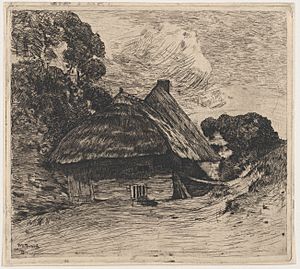The Quadroons facts for kids
Quick facts for kids "The Quadroons" |
|
|---|---|
| Author | Lydia Maria Child |
| Country | United States |
| Language | English |
| Published in | Liberty Bell |
| Publication date | 1842 |
"The Quadroons" is a short story written by the American writer Lydia Maria Child (1802-1880). It was published in a book called The Liberty Bell in 1842. This important story tells about the life and sad death of a mixed-race woman and her daughter in the early 1800s. At that time, slavery was common in America.
Lydia Maria Child helped create a common idea in literature called the "tragic mulatta." This idea described a mixed-race woman whose life often ended sadly because of the rules of slavery. Many other writers later used this idea in their anti-slavery stories. Years later, Harriet Jacobs's true story, Incidents in the Life of a Slave Girl, which Lydia Maria Child helped edit, also used this theme. However, Jacobs's story showed her main character having more control over her own life than Child's characters did.
Contents
About the Author and Story
Lydia Maria Child (1802-1880) was a very important writer who spoke out for Native Americans, women, and enslaved people. She was an abolitionist, meaning she worked to end slavery. In the 1830s, she and her husband joined a group of anti-slavery reformers led by William Lloyd Garrison.
Experts say that Child was the first to introduce the idea of the "tragic mulatta" in American literature. This was a mixed-race woman in a society where slavery existed, and her life usually ended in sadness. In the United States, many laws dealt with miscegenation, which meant mixed-race marriages were against the law. Also, a legal rule called Partus sequitur ventrem meant that children born to an enslaved mother would automatically be enslaved themselves. This meant they "belonged" to the person who enslaved their mother.
The "tragic mulatta" character was often a mixed-race woman who looked almost white. She might fall in love with a white man, but the law made it impossible for her to live freely or marry him. These stories almost always had a sad ending.
Story Summary
The story takes place in a small house in Augusta, Georgia, before the Civil War. The two main characters are Rosalie, who is a "quadroon" (meaning she was one-quarter Black), and Edward, a "Georgian" (a white man from Georgia). They live together in a loving relationship, even though the law did not recognize their marriage. Because Rosalie was partly African-American, she could not legally marry a white man. They lived as if they were married, but she had no legal rights as his wife. They had a daughter named Xarifa, who grew up protected in their home.
Edward later wanted to become a politician. To gain power, he married a rich white woman, who was the daughter of an important politician. This act destroyed his relationship with Rosalie. He asked Rosalie to stay with him in a different way, but she refused because she felt it was wrong. Rosalie and Xarifa lived alone in the cottage until Rosalie died from a broken heart after losing Edward.
Xarifa was cared for by teachers, including a young man named George Elliot, whom her father had hired. Edward died without a will, but his wife continued to provide for Xarifa.
Xarifa and her harp teacher, George, fell in love. They planned to move to France together. However, Xarifa was sold before they could escape. It turned out that Rosalie's mother had been enslaved, and her owner had never officially freed her. Because of this, Rosalie and her daughter Xarifa were still legally the property of the owner's family.
Xarifa was sold at an auction to a man who tried to win her over with flattery and gifts, but she refused to be with him. Xarifa and George planned another escape, but another enslaved person betrayed them. George was shot and killed during the attempt. After this, Xarifa also died.
Main Characters
- Rosalie: She is the "quadroon" woman the story is named after. She looks almost white and loves Edward, even though she knows they cannot legally marry. She and her daughter, Xarifa, live in a quiet cottage in Georgia until Edward leaves to marry a white woman.
- Edward: He is a wealthy man from an old Southern family. He falls in love with Rosalie and lives with her. But his desire to become a politician leads him to marry the daughter of an important man. He later dies after falling off his horse.
- Xarifa: She is Rosalie's daughter and is an octoroon (meaning she was one-eighth Black). She lives a protected but sad life that ends tragically. Her grandmother's former owner's family finds papers that claim ownership of her. Since slavery was passed down from the mother, Xarifa legally belonged to them, and they sold her at an auction.
- George: He was the harp teacher Edward hired for Xarifa. He fell in love with Xarifa and planned to run away to France with her. However, their plan was discovered, and he was shot during their escape attempt.
Story Themes
Love and Society
The descriptions of the natural world in "The Quadroons" were seen as a way to describe Rosalie and Edward's relationship. For example, the passion flower, which is described as being exotic, represents Rosalie's mixed race. The magnolia flower represents Edward as a Southern man. Their love, of course, could not be made legal through marriage. The story shows that the couple truly loved each other, and Rosalie wanted their marriage to be blessed by a higher power, even if the law did not allow it.
Story's Impact
Lydia Maria Child's writings dealt with important money, social, and race issues. Her work inspired movements both in literature and in society. One work influenced by "The Quadroons" is Clotel by William Wells Brown. Harriet Jacobs's Incidents in the Life of a Slave Girl, which is a true story and not fiction, has been seen as a "re-telling" of "The Quadroons" in some ways.
Publication History
"The Quadroons" was first published in 1842 in The Liberty Bell. This was an annual book of stories and essays that supported the abolitionist movement. It was published every year from 1839 to 1858. The story was published again in 1846 in a collection of stories called Fact and Fiction: A Collection of Stories.
Other Stories Like This
"Tragic Mulatto" Narratives
- Désirée’s Baby by Kate Chopin
- Imitation of Life by Fannie Hurst
- lola Leroy, or Shadows Uplifted by Frances Harper
- Passing by Nella Larson
- The Quadroon by Thomas Mayne Reid
- “The Sheriff's Children” by Charles W. Chesnutt
- A Sojourn in the City of Amalgamation by Jerome B. Holgate
- Uncle Tom's Cabin by Harriet Beecher-Stowe
- The White Girl by Vera Caspary



